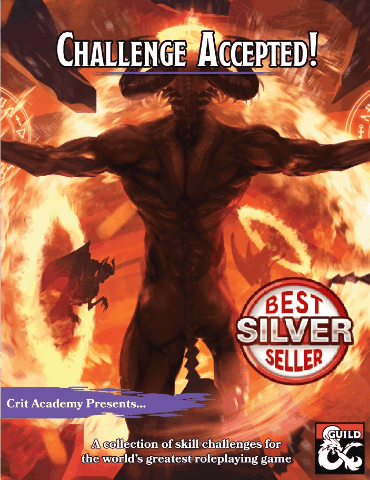D&D: Power Up Your Boss Encounters
- Justin Handlin

- Feb 14, 2022
- 5 min read
Updated: Mar 5, 2022

Guest Writer: John Bryant
John Bryant is a freelance D&D author and playtester. In his home games he alternates as a player and DM. You can find his work on the DMsGuild, including his first adventure The Cult of Beasts. When he's not doing D&D things, John plays Ultimate Frisbee and spends time with his family. Connect with John on Twitter and tell him about your experience boosting a boss in your game!
As a DM in Dungeons & Dragons, I hate the feeling when the boss encounter falls flat. We want these high-tension combats to feel epic and sometimes monsters at our party’s average CR can’t compete, so we look for ways to give our boss a boost without overwhelming the party.
I want to offer a new option in your DM toolbox. Give the boss an advantage through an environmental object that the party can nullify. When we think of combat environments we often think of terrain, hazards, or particularly shaped rooms. These are good in the right circumstances, but as a theater of the mind DM I go a different route. In my adventure The Cult of Beasts, I use a shrine.
While Brother Martin fights within 30 feet of the shrine, he is surrounded by black tendrils that emanate from it, granting him advantage on spell attack rolls, and imposing disadvantage on saving throws against any spells he casts.
A character within 5 feet of the shrine can use an action to disrupt the shrine’s magic by calling down divine wrath upon it with a successful DC 13 Intelligence (Religion) check, draw out its negative energy with a successful DC 13 Intelligence (Arcana) check, or shatter it with a successful DC 13 Strength (Athletics) check. The shrine can also be attacked (AC 14, 20 hit points, and resistance to poison and psychic damage).
This shrine gives the boss a little more oomph in combat, making them a little scarier, but it’s not going to break the balance. The boss may hit every round, but that can happen anyway in sessions when the DM is rolling high.
This approach doesn’t bog the fight down with additional actions or more choices to consider. Adding low CR enemies becomes more for the DM to track and can quickly tilt odds away from the players. Legendary actions are helpful for higher level bosses, but don’t make as much narrative sense at low levels. Plus as a DM I often get pulled into the rhythm of initiative, forgetting to use the legendary actions or slowing combat down when I interrupt a player to fit one in. With the shrine the boss still does exactly what it does; it just does it a little better.
Narratively, this object also helps signal the boss is in charge because they have this extra power granted by the shrine. Other strong lieutenants don’t challenge the boss because they may not have access to the same power. Plus these objects can add a cinematic flair to combat. The DM can describe the epic effect when the barbarian shatters the obelisk or the cleric cleanses the altar in holy fire.
Make sure to subscribe to our newsletter so we can help you on your future adventures. Newsletter subscribers are also entered to win cool prizes each and every week. Check out our fellowship members for more great content. Visit our Youtube channel for our show episodes, actual play episodes, and our tips & tricks videos. Support us on Patreon to get weekly Dungeons and Dragons loot!
Finally the players’ are free to ignore the altar entirely, maintaining player agency in their tactics. Video games which require you to defeat the boss’ “shield” or target specific aspects first work because players can use their save point to learn and restart the game. Putting similar encounters into D&D which has no do-overs can feel like “gotcha” moments to players. With the shrine the party is free to ignore it and accept the associated advantages, focusing all their attention on the boss.
That’s why I like this option from the DM’s perspective. Now let’s think about how these objects are fun for players too.
First, having this object in play gives creative players an opportunity to feel smart. They can react to your descriptions and plan accordingly. It’s like a mini-puzzle inside of combat. There’s no way to turn off legendary actions and most combat environments are unchangeable. But destroying the object giving the boss extra abilities feels incredibly satisfying.
Second this gives characters who aren’t combat-optimized or are running low on resources a solid way to contribute. The wizard spent all high-level spell slots already? They can use Arcana to disable the shrine. The barbarian can’t reach the boss this turn for a melee attack? They can change direction and knock that statue over.
So if I’ve convinced you to give this approach a try, let’s think through how to create one of these boss-boosting objects.
First question: what is the object in question? When dealing with cults or religious figures, shrines or altars are an easy choice. Other physical structures like obelisks, statues, pillars, or spires work well. With some creativity the sky’s the limit, recognizing that the object you choose will impact what skills make sense.
Next, what skills can the players use? You could leave these open to whatever your players’ creativity in the moment, but I like to have a couple ready, especially if a player asks what skills they could use first. If you’re creating this challenge for your home table, you can tailor these to skills your players have or typically use.
Having a mix of skills ensures that different characters can get involved, regardless of their build. Typically that means Strength (Athletics) or a straight Strength check for martial characters. I tend to gravitate towards Intelligence-based skills like Arcana, Nature, and Religion for these, but again that will depend on your party and the object you’ve chosen.
For setting the skill DC, I highly recommend this article by Merric Blackman to help settle on the right range of challenge and player success. Finally giving the object an AC and hit points is helpful for parties that are combat-focused and to allow the Wizard’s Fireball to be extra effective.
I hope for your next boss encounter you’ll try adding one of these objects to challenge your players!
Author: John Bryant
John Bryant is a freelance D&D author and playtester. In his home games he alternates as a player and DM. You can find his work on the DMsGuild, including his first adventure The Cult of Beasts. When he's not doing D&D things, John plays Ultimate Frisbee and spends time with his family. Connect with John on Twitter and tell him about your experience boosting a boss in your game!
Thank you for reading our blog. If you enjoy the content and want to support us, visit our store or follow us on social media, join us on discord, youtube, and leave us a review.
Keep your blades sharp and spells prepared heroes!
*Crit Academy is an Affiliate of Amazon, DMsguild and DriveThruRPG*

















Comments